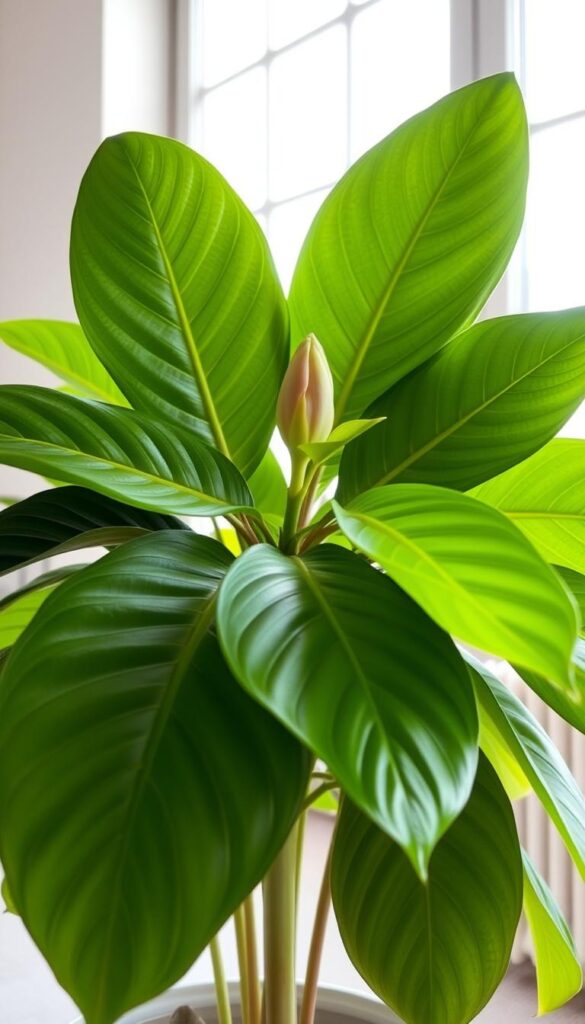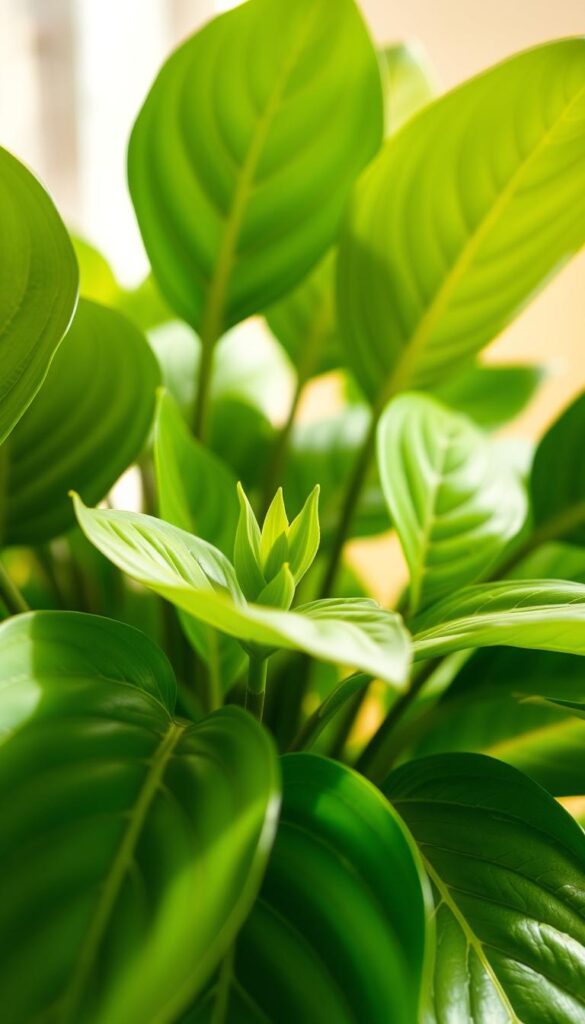Welcoming you to my journey of nurturing Philodendrons to bloom! These stunning plants have captivated my heart, and mastering the art of encouraging their flowers has been a transformative experience. It all began when I first noticed a delicate bloom on my Philodendron erubescens, sparking both excitement and curiosity.
Initially, I faced challenges in replicating that success. However, diving into expert guides, like Kiersten Rankel’s insightful work, revealed the crucial roles of light, temperature, and watering. Understanding the unique needs of different Philodendron species became key to their flourishing.
Through trial and error, I’ve gathered practical tips and expert advice. Factors like providing bright, indirect light and maintaining temperatures between 65-85°F (18-29°C) have proven essential. Timing is also critical, as Philodendrons often bloom in spring after a cooler winter period.
Here, I’ll share actionable strategies and insider tips, blending personal experience with proven methods. Whether you’re a seasoned gardener or a new plant enthusiast, this guide will walk you through the science and art of coaxing blooms from your Philodendron.
Understanding Your Philodendron’s Unique Blooming Process
Every philodendron has its own way of blooming, and understanding these unique traits is key to encouraging flowers. Just like in their natural habitats, these plants respond to specific environmental cues that signal it’s time to bloom.
Natural Flowering Cues and Environmental Triggers
In the wild, philodendrons often bloom in response to changes in their environment. Subtle drops in temperature at night and increased humidity can trigger flowering. These cues mimic the conditions of a tropical forest, where the plants naturally thrive.
- Light intensity plays a crucial role, as philodendrons prefer bright, indirect light to produce flowers.
- Humidity levels around 50-70% create an ideal environment for blooming.
Recognizing Different Species and Their Patterns
Not all philodendron species bloom in the same way. Some, like P. mamei, can flower almost year-round, while others, such as P. erubescens, bloom seasonally. The spathe and spadix are central to this process.
The spathe, often colorful, and the spadix, covered in tiny flowers, typically open at night. This nighttime blooming is a natural adaptation to attract pollinators in their native habitat.
- Observing your plant for early signs of blooming, like a swelling at the base, can help you anticipate when flowers will appear.
Practical Tips for how to get philodendron to flower
Helping your philodendron produce beautiful blooms can be a rewarding experience with the right approach. Over time, I’ve refined some practical strategies to encourage these plants to flower, and I’m excited to share them with you.
Optimizing Light, Temperature, and Humidity Settings
To create an ideal environment for blooming, consider the following tips:
- Place your philodendron near a sunny window for bright, indirect light. East- or west-facing windows are perfect for this purpose.
- Use LED grow lights if natural light is insufficient, especially during darker months. Aim for 12-14 hours of light per day.
- Maintain a consistent temperature between 65-85°F (18-29°C). Avoid placing plants near heating vents or drafty windows.
- Keep humidity levels between 50-70%. You can achieve this by placing the pot on a tray filled with water and pebbles or using a humidifier.
Fertilization and Soil Requirements for Blooming
Nutrition plays a crucial role in encouraging blooms. Here’s how to feed your philodendron:
- Use a high-phosphorus fertilizer (10-20-10) during the growing season (spring-fall) to promote blooming. Dilute the fertilizer to half the recommended strength to avoid burning the roots.
- Repot your philodendron in a well-draining, slightly acidic soil mix (pH 5.5-6.5) to prevent root rot and ensure proper nutrient absorption.
| Condition | Optimal Setting | Effect on Blooming |
|---|---|---|
| Light | Bright, indirect light | Encourages healthy growth and flower development |
| Temperature | 65-85°F (18-29°C) | Maintains metabolic balance for blooming |
| Humidity | 50-70% | Mimics natural habitat, promoting flower health |
| Fertilizer | High-phosphorus (10-20-10) | Supports flower production |
| Soil | Well-draining, acidic (pH 5.5-6.5) | Prevents root issues, enhances nutrient uptake |
Consistency and careful observation are key. Monitor your plant’s response to these conditions and adjust as needed. Troubleshooting issues early can make a significant difference in encouraging blooms. By following these practical tips, you’ll be well on your way to enjoying the beauty of your philodendron in full bloom.
Advanced Plant Care for Encouraging Blooms
As I continue my journey with philodendrons, I’ve discovered that advanced care techniques can make a world of difference in encouraging blooms. These methods go beyond the basics and require a bit more attention but yield remarkable results.
Pruning Techniques to Redirect Energy
I’ve found that pruning is a powerful tool to guide my philodendron’s energy toward blooming. By removing dead or excess leaves and stems, the plant can focus its resources on producing flowers instead of sustaining unnecessary growth. Timing is crucial—pruning in late winter or early spring allows the plant to conserve energy during its dormant period, which it can then use to bloom in the growing season.
When pruning, I look for any dead or damaged leaves or stems and carefully trim them off. This not only redirects energy but also improves air circulation, which is essential for healthy growth. It’s amazing how a little careful pruning can make such a big difference in the plant’s overall health and its ability to bloom.
Watering Practices: Striking the Perfect Balance
Watering is another area where balance is key. Philodendrons need consistent moisture, but overwatering can be detrimental. I make sure to water my plant thoroughly, allowing the top inch of soil to dry out between waterings. This ensures the roots stay moist but never waterlogged, which can lead to root rot and prevent blooming.
Humidity is also a factor I monitor closely. Maintaining a humidity level between 50-70% creates an environment similar to the plant’s natural habitat. I use a humidifier to keep the air around my philodendron moist, especially during drier months. Even small adjustments in humidity can have a significant impact on the plant’s ability to bloom.

Regular checks, especially at night when the plant might show subtle changes, help me stay on top of its needs. By paying attention to these details, I’ve been able to encourage my philodendron to bloom more frequently and vibrantly than ever before.
Understanding Philodendron Propagation and Hybridization
Exploring the fascinating world of philodendron propagation has been a rewarding journey. This process not only expands your plant collection but also deepens your connection with these incredible species. Whether you prefer seed propagation or vegetative methods, each approach offers unique benefits and challenges.
Comparing Seeds and Vegetative Methods
When it comes to propagating philodendrons, there are two main paths: seed propagation and vegetative methods. Seed propagation allows for genetic diversity, which can lead to exciting new traits. However, it’s a slower process and requires careful pollen collection. On the other hand, vegetative methods, like stem cuttings, ensure identical offspring and are generally faster.
| Method | Advantages | Challenges |
|---|---|---|
| Seed Propagation | Genetic diversity, potential for new traits | Time-consuming, requires precise conditions |
| Vegetative Propagation | Faster results, identical plants | Limited genetic diversity |
Managing Pollen Collection and Fruit Development
My experiments with pollen collection have taught me patience and precision. The spadix produces pollen, which must be collected and stored properly to ensure successful pollination. I use plastic bags to safeguard the process, creating a controlled environment that mimics natural conditions.
After pollination, the inflorescence develops into fruit, a process that requires careful monitoring. Signs of successful pollination include the swelling of the spadix and the eventual ripening of the fruit. This journey from flower to fruit is a testament to nature’s remarkable reproductive strategies.
Seasonal and Environmental Adjustments for Year-Round Blooming
Keeping your philodendron blooming throughout the year requires careful attention to seasonal changes and indoor conditions. By mimicking the plant’s natural tropical environment, you can encourage blooms even during colder months.
Adapting to Seasonal Shifts and Changing Conditions
Seasonal shifts can disrupt your philodendron’s bloom cycle. To counteract this, adjust humidity and light exposure. In winter, use LED grow lights to maintain adequate brightness, and employ a humidifier to keep the air moist.
Monitoring Indoor Environments Like a Pro
Modern tools like hygrometers and grow lights help fine-tune your plant’s environment. Regularly check humidity levels and adjust as needed, especially during transitional periods. This proactive approach ensures your philodendron thrives year-round.
| Season | Adjustments | Effect on Blooming |
|---|---|---|
| Spring/Summer | Increase light exposure; maintain high humidity | Encourages vigorous growth and blooming |
| Autumn/Winter | Use grow lights; reduce watering slightly | Maintains health during dormant period |

By creating microclimates and adjusting care routines, you can help your philodendron bloom consistently. Experiment with small changes to find the perfect balance for your plant.
Wrapping Up My Personal Philodendron Journey
Reflecting on my journey with philodendrons, I’ve come to appreciate the beauty of nurturing these plants to bloom. From the initial challenges to the joy of seeing those first flowers, every step has been a lesson in patience and adaptability.
Key to success are consistent conditions—bright light, stable temperatures, and balanced humidity. These elements create an environment that mimics their natural habitat, encouraging blooms. Understanding each species’ unique needs is equally important, as some thrive in specific settings while others adapt more readily.
My advice is simple: stay observant, adjust with the seasons, and remain patient. Each philodendron tells a story through its leaves and blooms, guiding you toward the right care. Embrace the journey, experiment, and share your discoveries with fellow plant enthusiasts.
Let’s continue this horticultural adventure together, celebrating the small victories and learning from every challenge. Happy planting!
